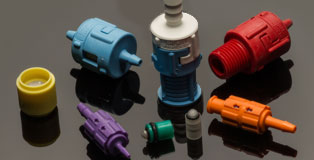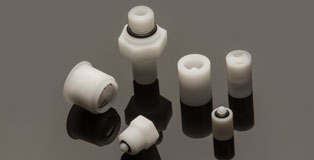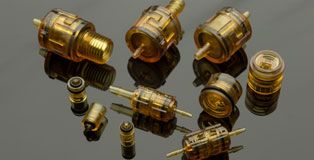Smart Products USA offers 9+ plastic body materials for our valves. Below is a basic overview of each. For optimal valve performance, it is important to discuss all liquids/gasses coming into contact with the valves, as well as environmental conditions with a Product & Application Specialist. Once we select a plastic, o-rings, and pressure requirements, we can create test samples based on a specific project criterion.
If your application requires color coding for ease of assembly, click here to learn more about this option.
Questions? Contact us here or call 828-595-8107.
Polypropylene
Polypropylene can be found in a wide variety of plastic products from chairs to toys, but it is especially valued by us as the go-to material for our check valves. In fact, approximately 75% of our check valves are created in polypropylene because it will work in most applications (appeals to engineers) and remains an economical choice (bonus for purchasers). We also have the capability to produce polypropylene in a variety of different colors for applications that call for color coding.
Characteristics:
- Performs up to 180° F
- Has a wide spectrum of chemical resistivity, and it is especially good with acidic acid
- Holds up against ware
- Works well with gamma sterilization and/or autoclaving
- Affordable
Available in:
Series 100 Cartridge Valves
Series 100 Specialty Valves
Series 200 NPT Valves
Series 300 Modular Valves
Series 500 Miniature Modular Valves
Nylon
Nylon 6 typically works best for air/gas applications that require a slightly higher heat resistance versus other plastics. If your application operates at a temperature range over 180° F, Nylon 6 is an ideal option because it works well up to 250° F. Smart Products manufactures Nylon 6 in black and natural; the black color option is ideal for customers who want the valves to blend in with a particular application.
Characteristics:
- Performs up to 250°F
- Works well with air/gasses
- Available in a black color option for discretion
Available in:
Series 100 Cartridge Valves
Series 100 Specialty Valves
Series 200 NPT Valves
Series 300 Modular Valves
Note: Nylon is not recommended for liquid applications because it tends to swell over time.
Acrylic
Acrylic is transparent, very strong, and ideal for hot or cold environments. And, it is the best plastic choice for applications working with mineral oils.
Characteristics:
- Performs at a temperature range from -76°F to 194°F
- Excellent resistance to mineral oils
- Transparent
- Good UV Resistance
- Can be gamma radiated
- Can be solvent bonded
- Very strong (rated as having a good tensile strength)
Available in:
Series 100 Cartridge Valves
Series 100 Specialty Valves
Acetal (Delrin®)
Acetal is a solid choice if you are looking for a compact, high-resistance valve that can withstand tough environments.
Characteristics:
- Performs at a heat resistance between 300-400° F
- UV Stability
- Strength
- Stiffness
- Versatility with different chemicals
Available in:
Series 100 Cartridge Valves
Series 100 Specialty Valves
Series 200 NPT Valves
Click each series page to view if this material is available in a specific valve model.
PVDF
PVDF (Polyvinylidene Fluoride) is a great choice for applications requiring the highest purity, strength, and resistance to solvents, acids, bases, and heat, as well as smoke generation in the event of a fire. For devices dealing with ozone, this plastic is the number one option.
Characteristics:
- Performs up to 300°F
- Good thermal stability
- High tensile strength
- High impact resistance
- Excellent UV resistance
- Extremely high purity
- Overall excellent corrosion and chemical resistance
- Easily fabricated into finished parts
Available in:
Series 100 Cartridge Valves
Series 100 Specialty Valves
Series 200 NPT Valves
Series 300 Modular Valves
Series 500 Miniature Modular Valves
Polycarbonate
High impact, high temperatures, and semi-transparent are all excellent attributes of polycarbonate, but it’s the biocompatible ISO 10993 compatibility rating that makes this plastic an ideal choice for medical applications.
Characteristics:
- Performs at a temperature range between 40° to 250° F
- Good chemical resistance with alcohols and diluted acids
- Semi-Transparent
Available In:
Series 100 Cartridge Valves
Series 100 Specialty Valves
Series 500 Miniature Modular Valves
Ultem®
Ultem® is your go-to plastic when your application requires high heat, flame, or solvent resistance. This plastic also has an added bonus of being EU, Class VI, or ISO 10993 compliant.
Characteristics:
- Performs between 200°F to 400°F
- Works well with ozone
- Compatible with oils, greases, lipids, detergents, disinfectants, lactic acid, freon, acetone, certain sodiums, and most caustic fluids
- Semi-transparent
- Good flame resistance
- Able to withstand gamma radiation, autoclaving, and steam sterilization, as well as ozone
Available In:
Series 100 Cartridge Valves
Series 100 Specialty Valves
Series 300 Modular Valves
Series 500 Miniature Modular Valves
ABS
ABS is an ideal body material for applications exposed to really cold environments.
Characteristics:
- Performs at a temperature range from -4°F to 176°F
- Works well with glycerine, inorganic salts, alkalis, many acids, most alcohols, and hydrocarbons
Available in:
Series 100 Cartridge Valves
Series 100 Specialty Valves
Series 200 NPT Valves
Series 300 Modular Valves
Note: ABS is only recommended for short term use with weak acids, and it is not a good choice for strong acids and solvents, ketones, aldehydes, esters, and some chlorinated hydrocarbons. For customers who require gamma radiation, we tested ABS for this type of exposure, and it received an “A grading,” which means it had no visual or functional changes. However, note that ABS cannot be autoclaved and has a low UV resistance. Valves in ABS are typically created via injection molding, but this plastic also does really well with ultrasonic welding.
Radel® 5000
Radel® is known for its ultra high toughness and ability to withstand high temperatures.
Characteristics:
- Performs up to 375°F
- Good chemical resistance, as well as resistant to acids, bases and detergents
- Sterilizable with autoclaving, E-beam, ethylene oxide, radiation and steam
- Flame Retardant
- Good thermal stability
- High resistance to environmental stress cracking
Available In:
Series 100 Cartridge Valves
Series 100 Specialty Valves
Series 300 Modular Valves










